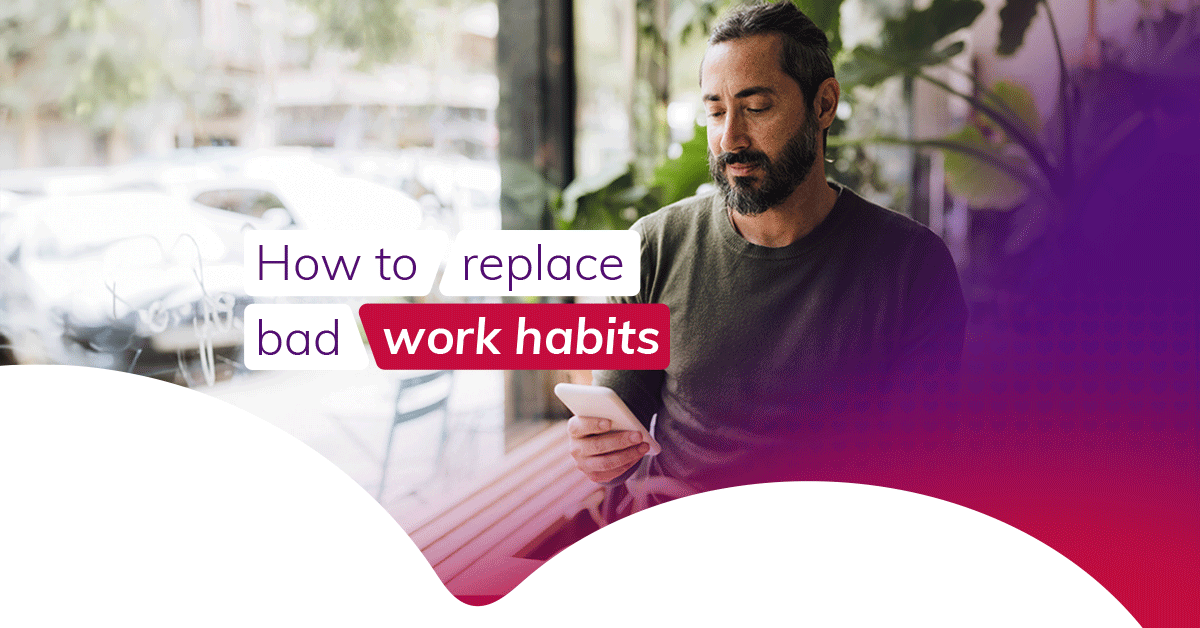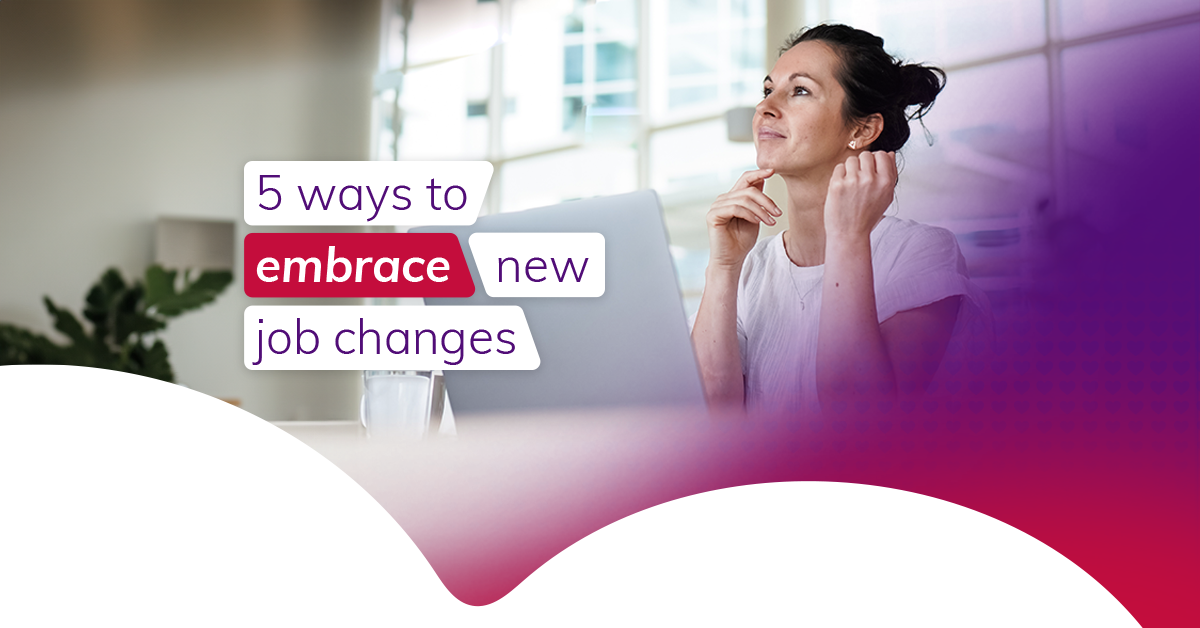

‘Identify your triggers’: how to replace bad habits at work
Before you can break bad work habits, you need to know what’s behind it. Vhi Health Coach Martina Breen talks you through the importance of curiosity with compassion, how to identify triggers, and methods for putting more productive behaviours in place.
Everything we do stems from learned behaviours designed to ensure that our needs are met. These are based on our deep-rooted beliefs, which are essentially just thoughts we keep thinking. As a result, our life is full of habits – behaviours we repeat in an unconscious and automatic fashion. We’re habit-forming creatures; it’s just what we do. And we’re also creatures that hate discomfort. So, when we have a need, we reach out for whatever can meet it. If something gives us pleasure, we move towards it, and keep repeating it.
Bad work habits come into play when our behaviours are based on instant gratification. The tendency for this varies from person-to-person. Some of us are ‘prolonged gratification’ people who can easily act with their long-term interests in mind, while some of us are more likely to go for soothing techniques that only offer short-term relief. We all know these behaviours: “I need to check my phone before I write that report” or “I’ll just have a nice cup of tea first.” When these more mindless activities start to affect our work and our lives, we can say they’re bad habits. So, how do we go about changing our more negative work habits?
Ease yourself in
You might have heard the phrase “change a habit in 21 days” before, but is there real merit to it? Certainly, if you spend three weeks consciously and consistently trying to answer emails first thing in the morning, or going to the gym at lunch, you will feel the difference. But in my experience, it really is ‘how long is a piece of string?’. It comes down to whatever need the habit is fulfilling. Often, you’ll find there are layers of habits working together to do just that, making them tough to pick apart in 21 days. You didn’t become like this overnight and you’re not going to become unlike it overnight. So, what you’re aiming for is small, incremental changes.
Awareness
We can’t change anything without awareness. The first step is naming the bad habit. You need to spot those detrimental behaviours, even if they seem deceptively virtuous: “I work through my lunch break every day and that leaves me stressed out by 5pm, so it’s a bad habit.”
For all bad work habits, there will be a trigger for your response, and then a reward for it. So, aim to identify your triggers. Maybe you get a work email notification and, instead of opening it, you head for social media first. So, you catch yourself before you start scrolling and realise you’ve a resistance to that work task. Catch yourself in the distraction and bring the fact that you’re moving off focus into your awareness.
You could spend an entire week keeping track of triggers, responses, and rewards. Make a note of the satisfaction that negative work habits give you. Truly ingrained bad habits have served a purpose. The more a habit does that, the harder it is to let it go.
Interrupting and replacing habits
Removing the distraction will make a big difference. If your attention is wandering when looking at the computer, make a conscious decision to only have one tab open at once. If you snack at your desk, take the food off the table. Simple boundaries and obstacles will help you “catch” yourself when a trigger strikes.
The trigger will still come. Acknowledge it: “I am triggered”. When we interrupt the habit repeatedly, it starts to lose its power and eventually it will break. Now, just saying “no” to a habit isn’t enough. We don’t give up bad work habits, we replace them with something else. So, instead of rewards that don’t serve us well over time, we need a constructive substitute.
Even a modification can help. If you’re spending hours scrolling on your phone, simply give yourself a small, set amount of time after a task is complete to use your phone. In that way, the need is still met. The habit hasn’t been taken away but modified in a healthier way.
The Seinfeld strategy
This psychological method is named after the comedian Jerry Seinfeld, who popularised it. He recommended getting a big wall calendar, with the entire year on one page, and hanging it on your wall. It’s helpful to put it in a place where you’ll be completing a task or switching a habit.
Get a red magic marker and put a big ‘X’ over every day you successfully complete a task or avoid a negative response. You begin to develop a chain of these marks, with research showing that visualising a sequence of consistent, small, repeated behaviours will increase your motivation.
Basically, your brain won’t want to break the chain. It’s a simple model that is often very effective. And it doesn’t have to be a wall calendar; find a visualisation technique that works for you.
Handling slip-ups
I’ve had people tell me in counselling “I’ve tried this and it’s not for me.” Quite often, they’ve fallen at the first hurdle and been defeated by an ‘all or nothing’ mentality. Something came up, they missed an appointment, they got scared, and they immediately think it won’t work. That’s natural. But if we think about how we developed as babies, we didn’t just get up one day and walk. We got up, we fell, we got up, we fell. So why do we think adults should learn something and immediately take to it?
It took time to “accomplish” our negative work habits. That’s why they’re automatic – we’re very accomplished at them!
With everything being so instant in today’s world, there isn’t enough compassion for our mistakes. If you allow yourself to be vulnerable, you can change incrementally with compassion. Use the ‘not knowing’ state to your advantage, and you’ll start to see that even slip-ups are valuable learning experiences that can eventually lead to real change.
Tackling time-based habits
Procrastination is one of the top bad work habits I hear about. When you procrastinate, you’re just trying to cope with stress or boredom. So many of these bad work habits are really soothing techniques, an attempt to alleviate anxiety. In reality, it only serves to feed that anxiety. You might think of your constant scrolling as a way of chilling out, but research has shown that your desire to do more of it only increases as you scroll, compounding stress.
When you’re tackling procrastination, you’ll benefit from having a clear workday structure. That certainty will lessen anxiety. So, make a work plan. Divide your day up into tasks and tackle them one at a time. Give yourself scheduled breaks in between.
The ‘frog technique’ is another approach, where you identify the task taking up most of your headspace. Then discipline yourself to complete it first. When you do, it will free up your mental space and stop stress being such an issue for the rest of the day.
We all have goals, but they can often be vague notions. People who are truly successful have clear, defined actions to go along with them. You need to be committed to a proper plan, or your days are wide open and you’re liable to be distracted by everything.
Other supports
Practicing mindfulness can be a great help in all of this. Even if you just take that up as a new habit, it’s going to bring all your bad habits into your awareness by default. They’ll simply show themselves as you sit with your thoughts.
Try to focus on why you want to change. It will give you extra encouragement. And leave yourself reminders! Write them on post-its and put them near your triggers or around your workspace.
Your main takeaway for breaking bad work habits should be to become more curious. Bring habits into your awareness and put your judgement in a box. You’ve got all the tools necessary to make a change. Judging yourself as you go about it will only make that change harder. So, embrace the process. And be kind to yourself.
If mindfulness is one of your new good habits, make sure you take a look at the offer available to Vhi members for meditation app subscriptions.
This content is for information purposes only and is not intended or implied to be a substitute for professional medical advice, diagnosis or treatment. Always seek advice from your GP or an appropriate medical professional if you have concerns about your health, or before commencing a new healthcare regime. If you believe that you are experiencing a medical emergency call 999 / 112 or seek emergency assistance immediately.

Martina Breen
Vhi Health Coach
M.A. MIAHIP SIAHIP MICP MNSHC Psychotherapist, Supervisor & Spiritual Director
.jpg/_jcr_content/renditions/cq5dam.web.1280.1280.jpeg?ch_ck=1699631419000)

